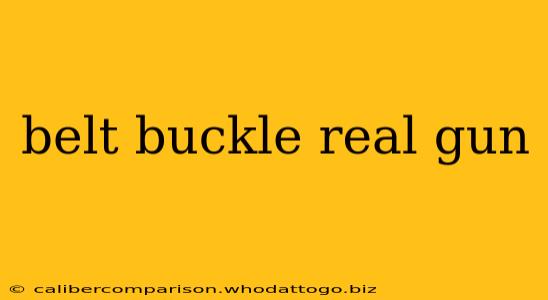The idea of a belt buckle concealing a real firearm might conjure images of spies and action movies. While the reality is less cinematic, belt buckle guns are a genuine, albeit controversial, method of concealed carry. This guide will explore the legality, functionality, practicality, and safety aspects of these unique firearms.
What is a Belt Buckle Gun?
A belt buckle gun is a small, often single-shot pistol designed to be concealed within a seemingly ordinary belt buckle. These firearms are typically .22 caliber or smaller, prioritizing concealability over firepower. They're not designed for extended combat but rather as a last resort self-defense option for those seeking extreme concealment.
Legality and Regulations
The legality of owning and carrying a belt buckle gun varies dramatically depending on your location. Always check your local, state, and federal laws regarding concealed carry and firearm ownership before considering purchasing one. Regulations concerning the size, type, and permitted carrying methods of firearms differ significantly. Possessing an illegal firearm can lead to severe penalties.
Key Legal Considerations:
- Concealed Carry Permits: In many jurisdictions, a concealed carry permit is required to carry any firearm, including a belt buckle gun. The application process and requirements vary widely.
- Restrictions on Weapon Type: Certain types of firearms, even if small, might be prohibited altogether.
- Background Checks: Purchasing a firearm usually involves a background check to ensure you're legally permitted to own one.
Practicality and Functionality
While the concept of a belt buckle gun is intriguing, its practicality is limited. The small size translates to limited accuracy and range. The difficulty of drawing and aiming quickly is also a significant concern. Furthermore, the ammunition capacity is usually very low, often only one shot. These factors make them less practical as a primary self-defense tool compared to other concealed carry options.
Limitations:
- Limited Ammunition: Extremely low capacity, typically a single shot.
- Accuracy and Range: Small size impacts accuracy and effective range significantly.
- Draw Time: Drawing the weapon quickly and safely can be challenging.
- Reliability: The compact design might compromise the firearm's reliability.
Safety Considerations
The safety of any firearm, especially one as concealed as a belt buckle gun, is paramount. Improper handling or accidental discharge can have devastating consequences.
Crucial Safety Practices:
- Proper Training: Seek professional firearms training before handling any firearm, especially one as unusual as a belt buckle gun.
- Safe Storage: Store the firearm unloaded and separately from ammunition, using a gun safe or locking device.
- Regular Cleaning and Maintenance: Ensure the gun is clean, well-maintained, and in proper working order.
- Never Point at Anything You Don't Intend to Shoot: This fundamental rule of firearm safety applies to all weapons, including belt buckle guns.
Alternatives to Belt Buckle Guns
If discreet concealed carry is your primary concern, consider exploring alternative options such as:
- Pocket Pistols: Small, easily concealable handguns designed for self-defense.
- Body Worn Holsters: Holsters designed for comfortable and safe concealed carry inside clothing.
- Other Concealed Carry Methods: Many innovative concealed carry methods and holsters exist, offering different levels of concealment and practicality.
Conclusion
Belt buckle guns represent a niche and often impractical approach to concealed carry. Their extreme concealment comes at the cost of significant limitations in functionality and safety. Before considering this option, thoroughly research your local laws, prioritize comprehensive firearms training, and carefully weigh the significant safety implications. Always remember that responsible gun ownership requires dedication to safety and adherence to all relevant regulations. Exploring alternative concealed carry methods might provide safer and more effective self-defense options.

